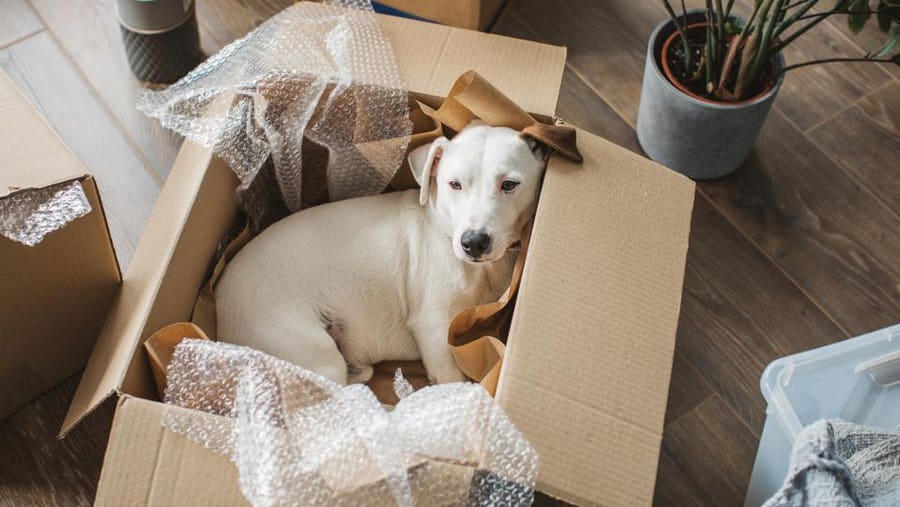Article-at-a-Glance
Identify the best dog parks for your furry friend after moving to a new area.
Use a detailed checklist to ensure a smooth relocation process for you and your dog.
Integrate into the local dog community and find socialization opportunities.
Customize your area map to include dog-friendly spots and essential services.
Discover how dog socialization classes can improve your dog’s park experiences.
“Tips And Tricks For Moving With Pets …” from www.forbes.com and used with no modifications.
Your New Best Friend: The Perfect Dog Park Awaits
Relocating to a new place is a significant life change, especially when it involves your four-legged family member. You want to make sure your dog feels just as at home in the new environment as you do. Finding the right dog park is a big part of that transition. It’s not just about a fenced area where dogs can run; it’s about finding a space where your dog can thrive, socialize, and remain safe.
Finding the Right Spot for Tail-Wagging Fun
When you’re new in town, it’s essential to understand that not all dog parks are created equal. Some are bustling hubs of activity, perfect for outgoing pups, while others are more serene, ideal for shy or older dogs. Consider your dog’s temperament and energy levels when choosing a park. Besides that, check if the park has separate areas for large and small breeds to ensure your dog’s safety and comfort.
Steps to a Smooth Park Transition for Your Pooch
Introducing your dog to a new park should be done gradually. Start with visits during off-peak hours to let your dog explore without the overwhelm of a crowded space. Keep your dog leashed initially to gauge their reaction to the new environment and other dogs. Positive reinforcement goes a long way, so bring along their favorite treats to make the park a place of happy associations.
Paws and Reflect: Rating the Local Parks
After you’ve visited a few parks, it’s time to reflect on which one best suits your dog’s needs. Pay attention to factors like cleanliness, availability of water sources, and the behavior of other dogs and their owners. These aspects can significantly affect your dog’s enjoyment and safety.
Is the park well-maintained and clean?
Are there separate areas for different sized dogs?
Do the other dogs there play well, or is there a lot of aggression?
Is fresh water available for the dogs?
How do the owners interact with their pets and others in the park?
Take note of these points after each visit, and soon you’ll have a clear idea of the best park for your pup.
Insider Tips on the Top Parks
Most importantly, don’t hesitate to ask local dog owners for their insights. They can offer you the lowdown on which parks have the best community vibe, which ones to avoid, and the best times to visit. Their experience can be invaluable in helping you make the right choice.
What to Look for in Park Reviews
Online reviews can be a treasure trove of information. Look for comments about the things that matter most to you and your dog, whether that’s cleanliness, safety, or the types of dogs that frequent the park. Because reviews are subjective, read them critically and look for patterns rather than one-off comments.
Example: “I’ve found that the Eastside Dog Park is particularly clean and well-maintained. The regulars are friendly, and there’s always someone with a ball to share. It’s our go-to spot for afternoon playtime!”
Such firsthand accounts can give you a real sense of what to expect.
Bark-Worthy Relocation Checklist
Before the Move
Before you even pack your first box, start preparing your dog for the move. This includes ensuring they are up to date with vaccinations, as some parks require proof of this. Also, order a new tag with your new address and contact information, and start to adjust your dog’s routine gradually to match what it will be like post-move.
Update vaccinations and get records from your vet.
Order a new ID tag with current contact information.
Begin to adjust your dog’s routine to the new schedule.
During the Move
On the big day, keep your dog’s anxiety low by maintaining a calm demeanor. Pack a travel bag for your dog with essentials like water, a bowl, their favorite toy, and a blanket that smells like home. If your dog is crate-trained, a crate can provide a safe and familiar space during the journey. Make frequent stops if you’re driving, allowing your dog to stretch, relieve themselves, and adjust to the changing environment.
And remember, your stress is contagious. If you stay upbeat and relaxed, your dog is more likely to mirror your mood.
After the Move
Once you’ve arrived at your new home, give your dog a tour on a leash to help them get acclimated. Set up their space with familiar items immediately, and maintain their routine as much as possible to provide a sense of normalcy. Be patient and give them plenty of affection—reassurance from you is the most comforting thing during this time of change.
Sniffing Out the Pack: Integrating into the Dog Community
Now that you’re settling in, it’s time to find your dog’s new pack. A well-integrated dog is a happy dog, and the local dog community can be a great resource for both of you.
Local Dog Groups and Meetups
Check out social media platforms and local bulletin boards for dog groups and meetups. These gatherings can be fantastic for socializing your dog and meeting other dog owners. They can also provide insider tips on the best vets, groomers, and pet stores in the area.
Remember, these groups are usually welcoming and love to see new faces—two-legged and four-legged alike!
Engaging with Neighbors and Their Dogs
Walking your dog is not only good for their health but also a prime opportunity to meet the neighbors and their pets. Friendly introductions can lead to future playdates and valuable connections. Your dog will start to recognize the local scents and sights, making them feel more at home. For more information on interacting with other dogs and their owners, read these dog park etiquette tips.
Marking the Territory: Customized Area Maps
Your new neighborhood is full of undiscovered spots for you and your dog to explore. Creating a customized map can help you navigate to all the dog-friendly locations.
Dog-Friendly Routes and Areas
Chart out dog-friendly walking routes, parks, and resting spots. Highlight areas with shade for hot days and shelter for unexpected rain. This preparation makes your walks stress-free and enjoyable for both of you. For more information, check out these dog park safety tips.
Emergency Vet Clinics and Pet Stores on the Map
It’s crucial to know the location of the nearest emergency vet clinic and pet store. Add these to your map along with the quickest route from your home. Having this information readily accessible can save precious time in case of an emergency.
The Canine’s Guide to Moving: Relocation E-books
There are numerous e-books available that provide comprehensive guides on relocating with your pet. These can be a goldmine of information, covering everything from pre-move preparation to settling into a new routine.
Benefits of Downloadable Guides
E-books offer the benefit of being portable and accessible on various devices. They often contain checklists, tips, and advice from experts that can help streamline the moving process for you and your dog.
How to Maximize the Use of E-books
Download your chosen guide well in advance and use it to create a personalized moving plan. Keep the e-book handy on your phone or tablet for quick reference during each phase of the move.
Social Paws: Dog Socialization Classes
If your dog is a bit shy or has been an only pet, consider enrolling them in dog socialization class. These classes can help your dog learn to interact positively with other dogs and people, making the transition to dog park life much smoother.
Look for classes that offer a mix of playtime, training, and rest periods. A well-rounded program will help your dog build confidence and good manners—key ingredients for a happy dog park experience.
Remember, moving with your dog is a journey you’re taking together. With a bit of planning and a lot of love, you’ll both find your place in your new community.
Finding the Right Class for Your Dog
When you’re new in town, enrolling your dog in a socialization class can be a game-changer. Look for classes that balance play with structure, where your dog can learn to interact with others in a controlled, positive environment. A good class will help your dog learn the ropes of social etiquette, which is crucial for enjoyable dog park visits.
How Socialization Enhances Dog Park Experiences
For example, Daisy was a rescue who was timid around other dogs. After just a few weeks in a socialization class, she gained confidence. Now, she’s the first to greet newcomers at our local dog park!
Socialization classes teach dogs how to read and respond to each other’s body language, which can prevent conflicts and encourage friendly interactions. Dogs that are well-socialized tend to have more fun and are less likely to cause or get into trouble at the dog park.
These classes also provide an opportunity for you to learn more about dog behavior. You’ll be able to spot signs of anxiety or aggression in your dog and others, which can help you intervene before a playful romp turns into a scuffle.
Moreover, socialization classes can be a great place to meet other dog owners. You’ll likely find people who are also new to the area and looking for dog park buddies, or long-time residents who can share their local doggy wisdom.
And don’t forget, attending these classes with your dog can strengthen your bond. It’s an investment in your dog’s well-being and your shared happiness.
FAQ
Got questions about moving with your dog and integrating into the local dog park scene? Here are some answers to help you navigate this exciting new chapter. For more detailed information, check out these tips on proper etiquette at the dog park.
Let’s dig into these common queries with some practical advice. For instance, when introducing your dog to a new park, consider the socialization classes available to help them adjust:
How do I introduce my dog to a new dog park after moving?
Start with visits during quieter times to allow your dog to get used to the space without the pressure of a busy environment. Keep your dog on a leash at first and walk around the perimeter, letting them watch and sniff around. Gradually introduce them to other dogs, monitoring their body language and comfort levels closely. Always reward positive interactions with praise or treats.
What are the key features to look for in a good dog park?
A good dog park should have features that cater to the socialization and play needs of dogs.
Secure fencing to prevent dogs from getting out.
Separate areas for large and small dogs to ensure safety.
Plenty of space for dogs to run and play without overcrowding.
Cleanliness, with readily available waste disposal stations.
Shade and water to keep dogs cool and hydrated.
These features contribute to a safe and enjoyable environment for all dogs and their owners.
How can I find local dog communities in my new area?
Start with a search on social media for local dog groups or check out community bulletin boards at pet stores and vet offices. Attending local events or dog shows can also connect you with fellow dog lovers. Don’t be shy—most dog owners are happy to chat and share information about the area.
After moving to Austin, I joined the ‘Austin Dog Lovers’ group on Facebook. It was a fantastic resource for finding the best dog-friendly spots and meeting new friends for weekend puppy playdates!
Are there any specific strategies for helping my dog adjust to a new environment?
Keeping a consistent routine is key. This includes feeding, walking, and playtime schedules. Surround your dog with familiar items like their bed, toys, and even an old t-shirt that smells like you. Be patient and present—extra cuddles and one-on-one time can go a long way in reassuring your pet.
What should I pack for my dog on moving day to ensure they’re comfortable?
Your dog’s moving day kit should include:
For new residents looking to integrate into the local dog community, understanding the ins and outs of Alameda dog parks and beaches is essential. This includes reading up on park reviews, having a solid relocation checklist, and knowing where to find dog socialization classes. Additionally, customized area maps can be a great resource for finding the best spots for your furry friend to play and meet other dogs. For those who are moving with pets, accessing relocation e-books can provide valuable tips for a smooth transition.






